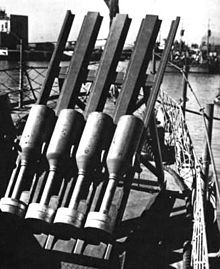
Summary
Mousetrap (anti-Submarine Projector, Marks 20 and 22) was an anti-submarine rocket launcher used mainly during World War II by the United States Navy[1] and Coast Guard.[2] Its development began in 1941 as a replacement for Hedgehog. Those were spigot-launched, which placed considerable strain on the launching vessel's deck, whereas Mousetrap was rocket-propelled. As a result, Mousetrap's four or eight rails for 7.2-inch (183 mm) rockets saved weight and were easier to install.

The rockets weighed 65 pounds (29 kg) each, with a 33-pound (15 kg) Torpex warhead and contact pistol, exactly like Hedgehog.
By the end of the war, over 100 Mark 22 Mousetraps were mounted in U.S. Navy ships, including three each on 12 destroyers,[1] and submarine chasers (usually two sets of rails).[3]
Statistics edit
- Round weight: 65 lb (29 kg)
- Warhead: 33 lb (15 kg)
- Range: about 280 m (920 ft)
- Firing speed: one round every 3 seconds (maximum)
- No. of rails:
- Mark 20: 4
- Mark 22: 8
Citations edit
- ^ a b "Anti-Submarine Projector Mk 20 & 22 (Mousetrap)". The Pacific War: The U.S. Navy. Retrieved December 12, 2013 – via MicroWorks.
- ^ "CUYAHOGA, 1927 WIX / WMEC / WSC-157". United States Coast Guard. March 13, 2008. Archived from the original on May 25, 2008. Retrieved October 8, 2008.
- ^ Priolo, Gary P. "Submarine Chaser SC-718". NavSource Naval History. Retrieved November 3, 2022.
Bibliography edit
- Fitzsimons, Bernard, ed. (1978). "Mousetrap". The Illustrated Encyclopedia of Twentieth Century Weapons and Warfare. Vol. 18. London: Phoebus Publishing. pp. 1946–1947. OCLC 271437802.
External links edit
- ASW Weapons of the United States of America at NavWeaps
- ASW Weapons of World War II of Russia / USSR at NavWeaps


